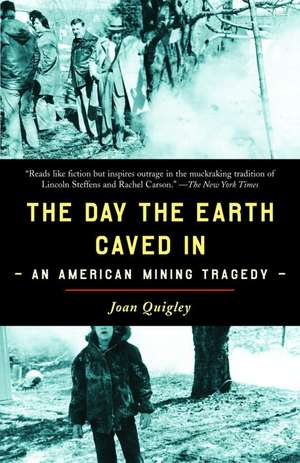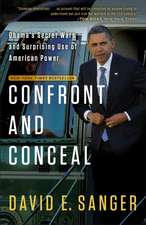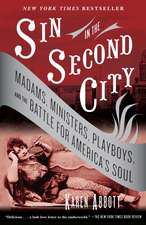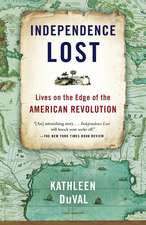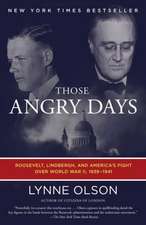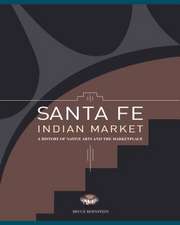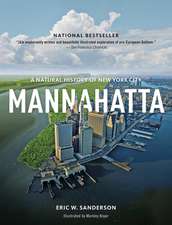The Day the Earth Caved in: An American Mining Tragedy
Autor Joan Quigleyen Limba Engleză Paperback – 31 mar 2009
Preț: 131.12 lei
Nou
Puncte Express: 197
Preț estimativ în valută:
25.09€ • 26.83$ • 20.92£
25.09€ • 26.83$ • 20.92£
Carte tipărită la comandă
Livrare economică 17 aprilie-01 mai
Preluare comenzi: 021 569.72.76
Specificații
ISBN-13: 9780812971309
ISBN-10: 0812971302
Pagini: 237
Ilustrații: 8-PP PHOTO SECTION
Dimensiuni: 133 x 205 x 16 mm
Greutate: 0.21 kg
Editura: Random House Trade
ISBN-10: 0812971302
Pagini: 237
Ilustrații: 8-PP PHOTO SECTION
Dimensiuni: 133 x 205 x 16 mm
Greutate: 0.21 kg
Editura: Random House Trade
Notă biografică
Joan Quigley first glimpsed the Centralia mine fire at age fifteen, during her grandmother’s funeral at St. Ignatius Cemetery. A former Miami Herald business reporter, she is a graduate of Princeton and of Columbia University’s Graduate School of Journalism. She is a recipient of the J. Anthony Lukas Work-in-Progress Award for this book.
From the Hardcover edition.
From the Hardcover edition.
Extras
CHAPTER ONE
Powder Keg Mary Lou Gaughan grabbed some Windex and paper towels and stepped onto her front porch. Overhead, beyond her red and white aluminum awning, the sun shone down on Wood Street, bathing her neighbors’ row homes in late-spring warmth. Summer, at long last, beckoned. Across town, similar routines unfolded, especially among neighbors who, like her, tackled chores left unfinished from Easter week: a litany of tasks inherited from immigrant mothers and grandmothers. Mattresses had to be flipped, linoleum polished, spring curtains hung. Outside, winter grime had to be wiped from front doors, a shine buffed onto parlor windows, and sidewalks swept free of leaves. Years earlier, when collieries spewed coal dust across the borough and women waged an almost daily battle against black silt, these tasks sprang from practicality and pride, cued, like the Resurrection, to the promise of rebirth. Now, with three days remaining until May 30 and scores of residents slated to converge on the borough for Memorial Day 1962, those who remained honored tradition and burnished appearances, unfurling American flags and draping them from porch railings and banisters. For many, a separate ritual awaited in the borough’s cemeteries, one for each religious denomination: Catholic, Protestant, Greek Catholic, and Russian Orthodox. In front of ancestral graves, they planted rows of red geraniums or purple, white, and pink petunias. Others tendered bouquets of yellow or red roses or, for the Irish, a wicker basket of green carnations. Still others tended to landscaping like groundskeepers, plucking weeds and mowing strips of grass the size of twin mattresses. Even before the mines closed, few Centralians risked the stigma of an untended family plot. Back on Wood Street, Mary Lou, a thirty-four-year-old garment worker with fair skin, pale blue eyes, and short curly brown hair, leaned into the concrete porch of her ranch-style house, coaxing a gleam from her three side-by-side parlor windows. On the inside, just a few inches from the glass, a Blessed Virgin statue presided over the center, as in a Renaissance triptych, garbed in white robes and gazing toward the sidewalk. Behind Mary Lou, a few feet away, her husband, Tony, a thirty-eight-year-old mine worker with Buddy Holly glasses and slicked-back hair, assumed his Sunday posture. Nestled in his rocking patio chair, he faced Locust Avenue, surveying his neighbors next door, where he grew up, and across the street. A row of four wood frame houses loomed to his right, buttressed by Nance Maloney’s two-story home, with its flat roof. A white picket fence demarcated her yard like rickrack trim stitched to the hem of a dress. Nance’s father, Jack McGinley, had owned a bar and hotel, a saloon awash in Depression-era bootleg whiskey. To Mary Lou, he projected the aura of the elite, lavishing his wealth on the parish and his daughter, from fur stoles to a college education. Down at the opposite end of the row, where Fran Jurgill lived, A-line eaves jutted over third-floor attic windows, like a child’s rendering of mountain peaks. At the end of the next block, Wood Street spilled onto Locust Avenue. Cars and trucks rumbled past, gunning for church, the other end of town, or destinations over the mountains, from Ashland to Bloomsburg and beyond. Behind Tony, over Mary Lou’s left shoulder, stood the row of houses—two halves of a duplex, called half-doubles, and an unattached single home—built and colonized by Michael and Anna Fowler Laughlin. The dump’s on fire! she heard a voice cry. Mary Lou glanced over toward Annie Donahue Ryan’s house, with its white wooden porch railings and façade of red shingles. In Annie’s backyard, a dirt path meandered into the woods east of town, a thicket of huckleberry and laurel bushes called the picnic grounds. Careering down the trail, just outside Annie’s chain-link fence, Mary Lou spotted Frank Jurgill, Jr., a fifteen-year-old who lived across the street. The dump’s on fire! he said again. Tony and Mary Lou, who knew Frank played in the woods behind the Ryans’ home, still couldn’t decipher what he was saying. Frank reached their house, winded and gasping for air. The dump’s on fire, he said. Mary Lou dropped her paper towels and flew down the steps. For generations, women in the coal region had raced to the colliery at the first word of an accident, praying their husbands and sons had escaped. Even now, after most of the mines had closed, the instinct to gather at a disaster site lingered, as if encoded in the collective DNA. When a fire engine rolled down a Centralia street, men, women, and children streamed out their front doors, some falling in behind it. In front of Annie Ryan’s house, Mary Lou swerved right, onto the gravel pavement that mapmakers and bill collectors called Wood Street. With Tony lagging, she sped past the Laughlin half-doubles, their façades shrouded with dark green shingles. At the far end of their row, she rounded the corner and peered across a grassy field to the southeast, the same vista she overlooked from her back porch. The Odd Fellows Cemetery lay straight ahead, enclosed behind a wrought-iron fence. St. Ignatius baseball field unfolded to her right, a grassy expanse next to the school. Now, to the left of the cemetery, she saw white smoke curling from the stripping pit that doubled as the town’s dump. One of the borough’s fire trucks, a red pumper with an open cab and running boards along the sides, lumbered toward the cemetery, where the burial grounds abutted the landfill. From their corner lot, Mary Lou and Tony patrolled Wood Street like beat cops, attuned to its rhythms and nuances. In the evenings, she knew, Jim Laughlin sauntered toward Locust Avenue, attired in a gray cardigan and sport coat. Three nights a week at 10:30 p.m., when Mary Lou heard high heels clicking on the sidewalk, she knew Annie Ryan had just returned from bingo in Mount Carmel, wearing a silk dress and pearls. Now, as she dashed along a hard dirt footpath strewn with tar paper, siding, floorboards, and oil drums, she wondered how the fire was started, and by whom. She and Tony hadn’t seen anyone heading up toward the dump—but someone could have gone around the back way. Outside the Odd Fellows Cemetery, just a few hundred feet from her home, Mary Lou came to a stop. The fire truck had parked along the cemetery fence, near the northeast corner. About twenty-five feet away lay the dump, a five-story ravine flecked with large gray rocks and sandy brown dirt. Clumps of slate and light brown rock encircled the rim, tossed aside in the quest for anthracite. Small trees sprouted from the banks, almost three decades after the last stripping contractor fled, with the Buck vein forsaken and exposed at the base. Five volunteer firemen, well tutored in emergency response and dump fires, had dragged a rubber hose from the truck to the edge. For years, household detritus had accumulated atop the coal seam at the base of the pit, creating a three-story repository of the borough’s castoffs: sofas, cardboard, newspapers, braided rugs, kerosene cans. Under the borough’s official policy, residents could pay one of two commercial haulers to drive their refuse to the landfill. Unofficially, if residents could tote it there themselves, they could chuck it. Either way, the site lured dumpers, rats, and amateur marksmen, including Tony and Mary Lou, who climbed down inside with a .22-caliber rifle, lined a log with beer and soda bottles and Mason jars, and shot them. Now, though, as the firefighters sprayed water onto the garbage, about fifteen feet beneath their feet, white smoke drifted up, twirling like funnel clouds. About a dozen spectators hovered outside the cemetery, spurred into action by the fire truck. Hanging around to critique the operation, they swapped information, sharing what they knew. Someone had flung hot ashes from a Heatrola, a coal-burning stove, onto the heap, but the flames were out, Mary Lou overheard one bystander say. In Centralia, where the dumps flared so frequently that the fire company had trouble mustering volunteers to respond, especially to an old Mammoth stripping pit on the borough’s west side, news of yet another outburst failed to excite. About twenty minutes later, Mary Lou retraced her steps and strolled home, back to her windows. For years, Centralia’s volunteer fire company had fashioned a spring ritual out of torching the borough’s dumps, after the snow melted and the rubbish dried, to banish odors, kill bacteria, and fend off vermin. During Holy Week, firemen crisscrossed the pit with gasoline, matches, and paper, setting the litter on fire. A few volunteers tarried nearby with .22 rifles, nailing rats as they scurried to the surface. Later that afternoon or early the next day, firefighters circled back with a tanker truck and hoses to drench the blaze. Clomping around in boots and gloves, they dissected their handiwork, ensuring the landfill no longer smoldered. The firefighters, however, did not proctor the landfill alone. The trustees of the Odd Fellows Cemetery, whose northern perimeter ran within a few feet of the dump, also policed conditions in the disposal area, a neighbor they tolerated but did not embrace. As May 30 approached, ensuring a host of downwind visitors, the president of the Protestant burial grounds lobbied for relief: He asked the fire department to clean the dump, meaning torch the top layer, before the holiday. Borough council, the secretary jotted in the May meeting minutes, received the suggestion very favorably. Before the firemen could incinerate the dump, though, someone else beat them to it. On Saturday, May 26, one of the borough’s approved dumping days, a commercial hauler named Curly Stasulevich heaved a load of refuse into the pit, including hot ashes from a coal-burning stove. In and of itself, his act did not embody negligence or malfeasance so much as routine. Across town, residents left their coal stove ashes out for collection in galvanized steel tubs, often while the residue still radiated heat. The haulers heaved their loads into the dump, where the ashes landed atop layers of discards prone to combustion, from paper to gasoline. Across Centralia and the coal region, where similar practices prevailed, the dumps flared on a regular basis, as often as once a week. The next morning, when the firefighters descended on the landfill with a pumper and a crew of five and Mary Lou trotted over to investigate, they found themselves battling a garbage flare-up. As Mary Lou heard, they thought they had extinguished the flames. Later in the day, when the firemen realized the blaze still raged, they dispatched a bulldozer to root around the landfill, exposing the fire, while they doused the burning garbage with water from the pumper. Still, two days elapsed before the fire company clamped a hose to a hydrant, several hundred feet away on Locust Avenue, and dragged the line to the landfill. Even then, as white steam and smoke trailed from the waste and the scent of burning wood, plastic, and paper hung in the air, one of the firemen drafted two teenage boys to man the hose. About an hour later, when darkness fell, the teenagers dragged a Naugahyde ottoman out of the dump, placed it at the brink, draped the hose over the stool, and went home, leaving the nozzle aiming moisture onto the heap. The next morning, Wednesday, May 30, a pool of water had formed at the base, six inches deep in some spots. But across the pit a few days later, steam rippled from the high wall, a clifflike face of exposed rock and anthracite left over from strip mining, soaring seventy-five feet above the coal seam. Centralia officials knew they had a problem as soon as they saw the steam. The state, which licensed the landfill, required the borough to crown the dump with clay every day, imposing a nonflammable barricade between the junk at the top and the carbon-dense rock at the bottom: a conglomerate that hadn’t quite metamorphosed into anthracite but still conducted heat. In a depressed coal town, however, where the general fund boasted $2,300, resources to ensure compliance had proven scarce. Borough officials added clay when they could, but not every day, and the fire took off, searing through the muck and swill at the surface, piercing whatever clay lay underneath, and igniting the rock, with its high carbon content. In the hours and days after the blaze erupted, it surged around the pit to the northeast, coursing through the rock like a dynamite fuse and homing in on the Buck vein. As far back as the mid-nineteenth century, colliery officials knew they had to attack a mine fire immediately. Mining treatises, keyed to the state’s foreman’s examination, devoted pages to the topic. For decades, so long as operators exploited their coal region wealth, they undertook whatever measures were necessary to trounce an underground inferno, including flooding the mine and gouging out the coal seam. Borough officials, who didn’t want to highlight conditions at the dump by asking for help, kept their predicament quiet, like a family secret, and dealt with it themselves. Still, word of the fire reached Harrisburg later that month. A mining engineer and state contractor who lived on Troutwine Street alerted the commonwealth’s top mining official, who dispatched a memo to an investigator, admonishing him to speak to borough council. The investigator, who was on vacation, said the blaze had been extinguished; the borough hired a bulldozer to disperse the refuse. But the fire wasn’t out. From the vein at the landfill’s foundation, it had plunged almost two hundred feet along the Buck outcrop into Centralia Colliery’s abandoned workings. Even a cursory glance at a mine map suggested where it would head next. From a wooded ridge about seventeen hundred feet east of Locust Avenue, the outcrop ran west on two fronts, hugging opposite sides of Locust Mountain. Viewed from above, it looked like a wishbone, with the spine facing east and the open-ended prongs, called dips, pointing west. The south dip veered behind St. Ignatius ballfield and away from the borough, toward Ashland and Mount Carmel. The north dip, which the dump straddled and the blaze now consumed, coursed from the Odd Fellows Cemetery toward Wood Street, where Mary Lou lived. From her backyard, it extended under Locust Avenue and around St. Ignatius Cemetery. The blaze, by now a full-fledged mine fire, also proved impossible to conceal. Vapors spurted from rock fissures along its route, marking its path like runway lights. Fumes wafted across Locust Avenue and into St. Ignatius Church, about nine hundred feet from the landfill. The borough closed the dump until further notice, rerouting haulers to Ashland and Mount Carmel. For Mary Lou, who maintained a scrapbook of newspaper photographs devoted to President Kennedy and his clan, the site acquired the aura of a news event, like a plane crash in her backyard. In July, she stood at the dump’s edge with a camera, memorializing the geysers of steam. Later, she tucked her snapshots into a leather-bound scrapbook: white clouds teeming from the pit. Next to the black-and-white images, she pasted two photographs of her two-year-old son, Tony, and his older sister, Patricia, perched atop a bulldozer outside the Laughlin homestead.
Powder Keg Mary Lou Gaughan grabbed some Windex and paper towels and stepped onto her front porch. Overhead, beyond her red and white aluminum awning, the sun shone down on Wood Street, bathing her neighbors’ row homes in late-spring warmth. Summer, at long last, beckoned. Across town, similar routines unfolded, especially among neighbors who, like her, tackled chores left unfinished from Easter week: a litany of tasks inherited from immigrant mothers and grandmothers. Mattresses had to be flipped, linoleum polished, spring curtains hung. Outside, winter grime had to be wiped from front doors, a shine buffed onto parlor windows, and sidewalks swept free of leaves. Years earlier, when collieries spewed coal dust across the borough and women waged an almost daily battle against black silt, these tasks sprang from practicality and pride, cued, like the Resurrection, to the promise of rebirth. Now, with three days remaining until May 30 and scores of residents slated to converge on the borough for Memorial Day 1962, those who remained honored tradition and burnished appearances, unfurling American flags and draping them from porch railings and banisters. For many, a separate ritual awaited in the borough’s cemeteries, one for each religious denomination: Catholic, Protestant, Greek Catholic, and Russian Orthodox. In front of ancestral graves, they planted rows of red geraniums or purple, white, and pink petunias. Others tendered bouquets of yellow or red roses or, for the Irish, a wicker basket of green carnations. Still others tended to landscaping like groundskeepers, plucking weeds and mowing strips of grass the size of twin mattresses. Even before the mines closed, few Centralians risked the stigma of an untended family plot. Back on Wood Street, Mary Lou, a thirty-four-year-old garment worker with fair skin, pale blue eyes, and short curly brown hair, leaned into the concrete porch of her ranch-style house, coaxing a gleam from her three side-by-side parlor windows. On the inside, just a few inches from the glass, a Blessed Virgin statue presided over the center, as in a Renaissance triptych, garbed in white robes and gazing toward the sidewalk. Behind Mary Lou, a few feet away, her husband, Tony, a thirty-eight-year-old mine worker with Buddy Holly glasses and slicked-back hair, assumed his Sunday posture. Nestled in his rocking patio chair, he faced Locust Avenue, surveying his neighbors next door, where he grew up, and across the street. A row of four wood frame houses loomed to his right, buttressed by Nance Maloney’s two-story home, with its flat roof. A white picket fence demarcated her yard like rickrack trim stitched to the hem of a dress. Nance’s father, Jack McGinley, had owned a bar and hotel, a saloon awash in Depression-era bootleg whiskey. To Mary Lou, he projected the aura of the elite, lavishing his wealth on the parish and his daughter, from fur stoles to a college education. Down at the opposite end of the row, where Fran Jurgill lived, A-line eaves jutted over third-floor attic windows, like a child’s rendering of mountain peaks. At the end of the next block, Wood Street spilled onto Locust Avenue. Cars and trucks rumbled past, gunning for church, the other end of town, or destinations over the mountains, from Ashland to Bloomsburg and beyond. Behind Tony, over Mary Lou’s left shoulder, stood the row of houses—two halves of a duplex, called half-doubles, and an unattached single home—built and colonized by Michael and Anna Fowler Laughlin. The dump’s on fire! she heard a voice cry. Mary Lou glanced over toward Annie Donahue Ryan’s house, with its white wooden porch railings and façade of red shingles. In Annie’s backyard, a dirt path meandered into the woods east of town, a thicket of huckleberry and laurel bushes called the picnic grounds. Careering down the trail, just outside Annie’s chain-link fence, Mary Lou spotted Frank Jurgill, Jr., a fifteen-year-old who lived across the street. The dump’s on fire! he said again. Tony and Mary Lou, who knew Frank played in the woods behind the Ryans’ home, still couldn’t decipher what he was saying. Frank reached their house, winded and gasping for air. The dump’s on fire, he said. Mary Lou dropped her paper towels and flew down the steps. For generations, women in the coal region had raced to the colliery at the first word of an accident, praying their husbands and sons had escaped. Even now, after most of the mines had closed, the instinct to gather at a disaster site lingered, as if encoded in the collective DNA. When a fire engine rolled down a Centralia street, men, women, and children streamed out their front doors, some falling in behind it. In front of Annie Ryan’s house, Mary Lou swerved right, onto the gravel pavement that mapmakers and bill collectors called Wood Street. With Tony lagging, she sped past the Laughlin half-doubles, their façades shrouded with dark green shingles. At the far end of their row, she rounded the corner and peered across a grassy field to the southeast, the same vista she overlooked from her back porch. The Odd Fellows Cemetery lay straight ahead, enclosed behind a wrought-iron fence. St. Ignatius baseball field unfolded to her right, a grassy expanse next to the school. Now, to the left of the cemetery, she saw white smoke curling from the stripping pit that doubled as the town’s dump. One of the borough’s fire trucks, a red pumper with an open cab and running boards along the sides, lumbered toward the cemetery, where the burial grounds abutted the landfill. From their corner lot, Mary Lou and Tony patrolled Wood Street like beat cops, attuned to its rhythms and nuances. In the evenings, she knew, Jim Laughlin sauntered toward Locust Avenue, attired in a gray cardigan and sport coat. Three nights a week at 10:30 p.m., when Mary Lou heard high heels clicking on the sidewalk, she knew Annie Ryan had just returned from bingo in Mount Carmel, wearing a silk dress and pearls. Now, as she dashed along a hard dirt footpath strewn with tar paper, siding, floorboards, and oil drums, she wondered how the fire was started, and by whom. She and Tony hadn’t seen anyone heading up toward the dump—but someone could have gone around the back way. Outside the Odd Fellows Cemetery, just a few hundred feet from her home, Mary Lou came to a stop. The fire truck had parked along the cemetery fence, near the northeast corner. About twenty-five feet away lay the dump, a five-story ravine flecked with large gray rocks and sandy brown dirt. Clumps of slate and light brown rock encircled the rim, tossed aside in the quest for anthracite. Small trees sprouted from the banks, almost three decades after the last stripping contractor fled, with the Buck vein forsaken and exposed at the base. Five volunteer firemen, well tutored in emergency response and dump fires, had dragged a rubber hose from the truck to the edge. For years, household detritus had accumulated atop the coal seam at the base of the pit, creating a three-story repository of the borough’s castoffs: sofas, cardboard, newspapers, braided rugs, kerosene cans. Under the borough’s official policy, residents could pay one of two commercial haulers to drive their refuse to the landfill. Unofficially, if residents could tote it there themselves, they could chuck it. Either way, the site lured dumpers, rats, and amateur marksmen, including Tony and Mary Lou, who climbed down inside with a .22-caliber rifle, lined a log with beer and soda bottles and Mason jars, and shot them. Now, though, as the firefighters sprayed water onto the garbage, about fifteen feet beneath their feet, white smoke drifted up, twirling like funnel clouds. About a dozen spectators hovered outside the cemetery, spurred into action by the fire truck. Hanging around to critique the operation, they swapped information, sharing what they knew. Someone had flung hot ashes from a Heatrola, a coal-burning stove, onto the heap, but the flames were out, Mary Lou overheard one bystander say. In Centralia, where the dumps flared so frequently that the fire company had trouble mustering volunteers to respond, especially to an old Mammoth stripping pit on the borough’s west side, news of yet another outburst failed to excite. About twenty minutes later, Mary Lou retraced her steps and strolled home, back to her windows. For years, Centralia’s volunteer fire company had fashioned a spring ritual out of torching the borough’s dumps, after the snow melted and the rubbish dried, to banish odors, kill bacteria, and fend off vermin. During Holy Week, firemen crisscrossed the pit with gasoline, matches, and paper, setting the litter on fire. A few volunteers tarried nearby with .22 rifles, nailing rats as they scurried to the surface. Later that afternoon or early the next day, firefighters circled back with a tanker truck and hoses to drench the blaze. Clomping around in boots and gloves, they dissected their handiwork, ensuring the landfill no longer smoldered. The firefighters, however, did not proctor the landfill alone. The trustees of the Odd Fellows Cemetery, whose northern perimeter ran within a few feet of the dump, also policed conditions in the disposal area, a neighbor they tolerated but did not embrace. As May 30 approached, ensuring a host of downwind visitors, the president of the Protestant burial grounds lobbied for relief: He asked the fire department to clean the dump, meaning torch the top layer, before the holiday. Borough council, the secretary jotted in the May meeting minutes, received the suggestion very favorably. Before the firemen could incinerate the dump, though, someone else beat them to it. On Saturday, May 26, one of the borough’s approved dumping days, a commercial hauler named Curly Stasulevich heaved a load of refuse into the pit, including hot ashes from a coal-burning stove. In and of itself, his act did not embody negligence or malfeasance so much as routine. Across town, residents left their coal stove ashes out for collection in galvanized steel tubs, often while the residue still radiated heat. The haulers heaved their loads into the dump, where the ashes landed atop layers of discards prone to combustion, from paper to gasoline. Across Centralia and the coal region, where similar practices prevailed, the dumps flared on a regular basis, as often as once a week. The next morning, when the firefighters descended on the landfill with a pumper and a crew of five and Mary Lou trotted over to investigate, they found themselves battling a garbage flare-up. As Mary Lou heard, they thought they had extinguished the flames. Later in the day, when the firemen realized the blaze still raged, they dispatched a bulldozer to root around the landfill, exposing the fire, while they doused the burning garbage with water from the pumper. Still, two days elapsed before the fire company clamped a hose to a hydrant, several hundred feet away on Locust Avenue, and dragged the line to the landfill. Even then, as white steam and smoke trailed from the waste and the scent of burning wood, plastic, and paper hung in the air, one of the firemen drafted two teenage boys to man the hose. About an hour later, when darkness fell, the teenagers dragged a Naugahyde ottoman out of the dump, placed it at the brink, draped the hose over the stool, and went home, leaving the nozzle aiming moisture onto the heap. The next morning, Wednesday, May 30, a pool of water had formed at the base, six inches deep in some spots. But across the pit a few days later, steam rippled from the high wall, a clifflike face of exposed rock and anthracite left over from strip mining, soaring seventy-five feet above the coal seam. Centralia officials knew they had a problem as soon as they saw the steam. The state, which licensed the landfill, required the borough to crown the dump with clay every day, imposing a nonflammable barricade between the junk at the top and the carbon-dense rock at the bottom: a conglomerate that hadn’t quite metamorphosed into anthracite but still conducted heat. In a depressed coal town, however, where the general fund boasted $2,300, resources to ensure compliance had proven scarce. Borough officials added clay when they could, but not every day, and the fire took off, searing through the muck and swill at the surface, piercing whatever clay lay underneath, and igniting the rock, with its high carbon content. In the hours and days after the blaze erupted, it surged around the pit to the northeast, coursing through the rock like a dynamite fuse and homing in on the Buck vein. As far back as the mid-nineteenth century, colliery officials knew they had to attack a mine fire immediately. Mining treatises, keyed to the state’s foreman’s examination, devoted pages to the topic. For decades, so long as operators exploited their coal region wealth, they undertook whatever measures were necessary to trounce an underground inferno, including flooding the mine and gouging out the coal seam. Borough officials, who didn’t want to highlight conditions at the dump by asking for help, kept their predicament quiet, like a family secret, and dealt with it themselves. Still, word of the fire reached Harrisburg later that month. A mining engineer and state contractor who lived on Troutwine Street alerted the commonwealth’s top mining official, who dispatched a memo to an investigator, admonishing him to speak to borough council. The investigator, who was on vacation, said the blaze had been extinguished; the borough hired a bulldozer to disperse the refuse. But the fire wasn’t out. From the vein at the landfill’s foundation, it had plunged almost two hundred feet along the Buck outcrop into Centralia Colliery’s abandoned workings. Even a cursory glance at a mine map suggested where it would head next. From a wooded ridge about seventeen hundred feet east of Locust Avenue, the outcrop ran west on two fronts, hugging opposite sides of Locust Mountain. Viewed from above, it looked like a wishbone, with the spine facing east and the open-ended prongs, called dips, pointing west. The south dip veered behind St. Ignatius ballfield and away from the borough, toward Ashland and Mount Carmel. The north dip, which the dump straddled and the blaze now consumed, coursed from the Odd Fellows Cemetery toward Wood Street, where Mary Lou lived. From her backyard, it extended under Locust Avenue and around St. Ignatius Cemetery. The blaze, by now a full-fledged mine fire, also proved impossible to conceal. Vapors spurted from rock fissures along its route, marking its path like runway lights. Fumes wafted across Locust Avenue and into St. Ignatius Church, about nine hundred feet from the landfill. The borough closed the dump until further notice, rerouting haulers to Ashland and Mount Carmel. For Mary Lou, who maintained a scrapbook of newspaper photographs devoted to President Kennedy and his clan, the site acquired the aura of a news event, like a plane crash in her backyard. In July, she stood at the dump’s edge with a camera, memorializing the geysers of steam. Later, she tucked her snapshots into a leather-bound scrapbook: white clouds teeming from the pit. Next to the black-and-white images, she pasted two photographs of her two-year-old son, Tony, and his older sister, Patricia, perched atop a bulldozer outside the Laughlin homestead.
Recenzii
“Reads like fiction but inspires outrage in the muckraking tradition of Lincoln Steffens and Rachel Carson.”—New York Times
“A real-life epic of brutally indifferent government, greedy corporations, and the unlikely heroes. You’ll feel enraged to know the truth of what happened in our mountains and proud of your fellow Americans who took on Goliath.”—John Passacantando, executive director, Greenpeace USA
“A thorough and often passionate account . . . The Day the Earth Caved In shines.”—Washington Post Book World
“Fascinating . . . [an] excellent study.”—Denver Post
“First-rate research and journalism.”—Kirkus Reviews, starred review
“It is quite a story.”— Wall Street Journal
“ Quigley’s riveting account of the nation’s most devastating mine fire will change the way you think about so-called natural disasters, and the emotions we attach to the places we call home. This is an extraordinary book.” —Sean Wilentz, author of The Rise of American Democracy
“If you can imagine a book that combines the gritty dignity of How Green Was My Valley with the muckraking of Silent Spring, then you have some sense of this deeply affecting work.”—Samuel G. Freedman, author of Upon This Rock
“Joan Quigley, the granddaughter of coal miners, has combined meticulous reporting and personal passion to bring us this important book — one that illuminates an underground blaze that many corporate and government officials sought to smother and conceal.” —Gay Talese, author of A Writer’s Life
“Quigley takes this complex story involving politics, science and history and weaves it into something that informs and entertains.”—Lexington Herald-Leader
“A real-life epic of brutally indifferent government, greedy corporations, and the unlikely heroes. You’ll feel enraged to know the truth of what happened in our mountains and proud of your fellow Americans who took on Goliath.”—John Passacantando, executive director, Greenpeace USA
“A thorough and often passionate account . . . The Day the Earth Caved In shines.”—Washington Post Book World
“Fascinating . . . [an] excellent study.”—Denver Post
“First-rate research and journalism.”—Kirkus Reviews, starred review
“It is quite a story.”— Wall Street Journal
“ Quigley’s riveting account of the nation’s most devastating mine fire will change the way you think about so-called natural disasters, and the emotions we attach to the places we call home. This is an extraordinary book.” —Sean Wilentz, author of The Rise of American Democracy
“If you can imagine a book that combines the gritty dignity of How Green Was My Valley with the muckraking of Silent Spring, then you have some sense of this deeply affecting work.”—Samuel G. Freedman, author of Upon This Rock
“Joan Quigley, the granddaughter of coal miners, has combined meticulous reporting and personal passion to bring us this important book — one that illuminates an underground blaze that many corporate and government officials sought to smother and conceal.” —Gay Talese, author of A Writer’s Life
“Quigley takes this complex story involving politics, science and history and weaves it into something that informs and entertains.”—Lexington Herald-Leader
